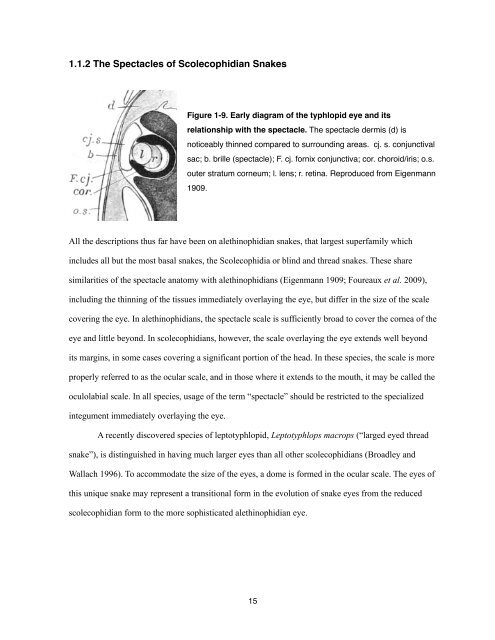Chapter 1, The Reptilian Spectacle - UWSpace - University of ...
Chapter 1, The Reptilian Spectacle - UWSpace - University of ...
Chapter 1, The Reptilian Spectacle - UWSpace - University of ...
Create successful ePaper yourself
Turn your PDF publications into a flip-book with our unique Google optimized e-Paper software.
1.1.2 <strong>The</strong> <strong>Spectacle</strong>s <strong>of</strong> Scolecophidian Snakes<br />
Figure 1-9. Early diagram <strong>of</strong> the typhlopid eye and its<br />
relationship with the spectacle. <strong>The</strong> spectacle dermis (d) is<br />
noticeably thinned compared to surrounding areas. cj. s. conjunctival<br />
sac; b. brille (spectacle); F. cj. fornix conjunctiva; cor. choroid/iris; o.s.<br />
outer stratum corneum; l. lens; r. retina. Reproduced from Eigenmann<br />
1909.<br />
All the descriptions thus far have been on alethinophidian snakes, that largest superfamily which<br />
includes all but the most basal snakes, the Scolecophidia or blind and thread snakes. <strong>The</strong>se share<br />
similarities <strong>of</strong> the spectacle anatomy with alethinophidians (Eigenmann 1909; Foureaux et al. 2009),<br />
including the thinning <strong>of</strong> the tissues immediately overlaying the eye, but differ in the size <strong>of</strong> the scale<br />
covering the eye. In alethinophidians, the spectacle scale is sufficiently broad to cover the cornea <strong>of</strong> the<br />
eye and little beyond. In scolecophidians, however, the scale overlaying the eye extends well beyond<br />
its margins, in some cases covering a significant portion <strong>of</strong> the head. In these species, the scale is more<br />
properly referred to as the ocular scale, and in those where it extends to the mouth, it may be called the<br />
oculolabial scale. In all species, usage <strong>of</strong> the term “spectacle” should be restricted to the specialized<br />
integument immediately overlaying the eye.<br />
A recently discovered species <strong>of</strong> leptotyphlopid, Leptotyphlops macrops (“larged eyed thread<br />
snake”), is distinguished in having much larger eyes than all other scolecophidians (Broadley and<br />
Wallach 1996). To accommodate the size <strong>of</strong> the eyes, a dome is formed in the ocular scale. <strong>The</strong> eyes <strong>of</strong><br />
this unique snake may represent a transitional form in the evolution <strong>of</strong> snake eyes from the reduced<br />
scolecophidian form to the more sophisticated alethinophidian eye.<br />
15
















